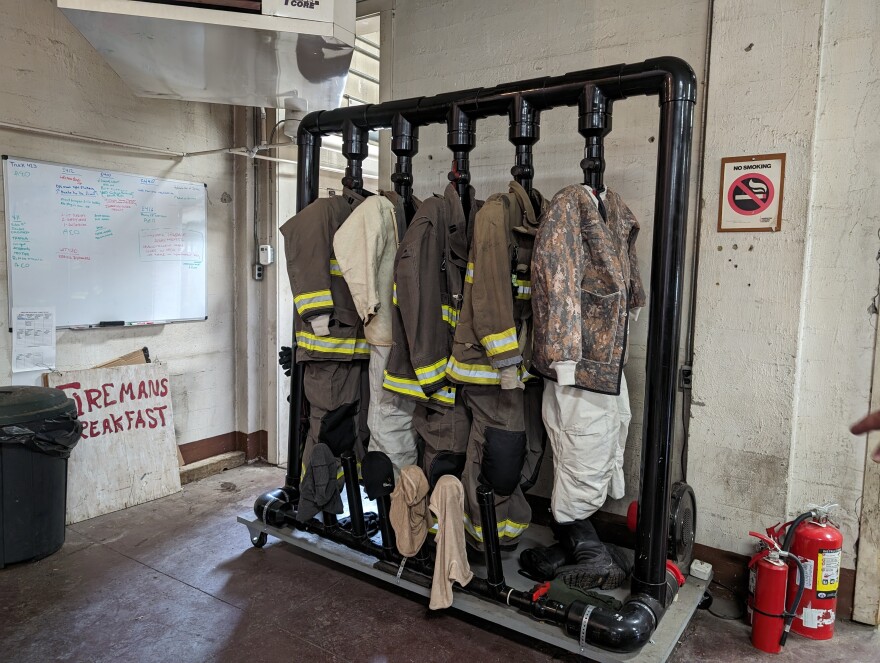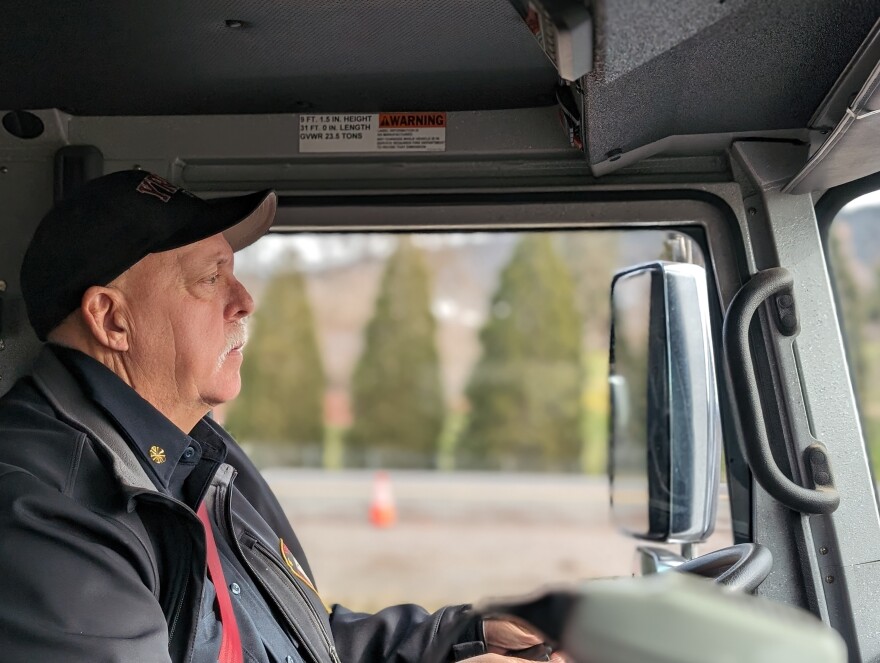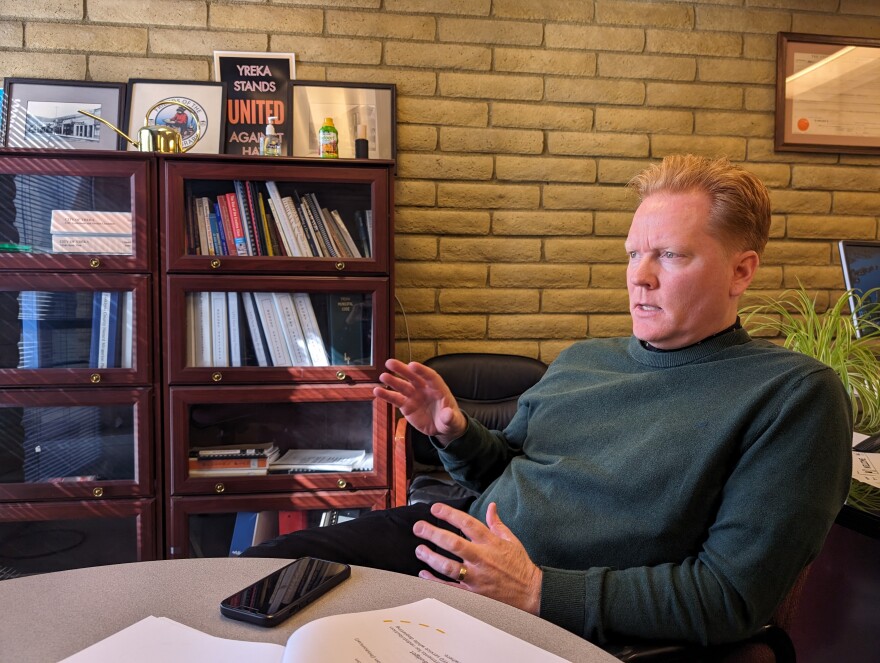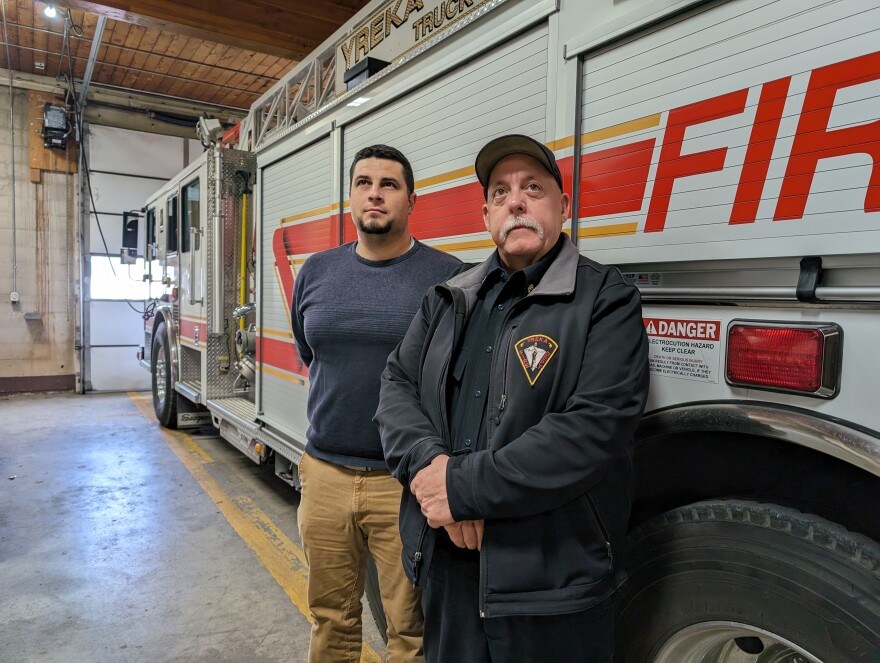Walking inside the fire hall in Yreka, there are so many interesting things to see. Fire Chief Jerry Lemos shows off the shiny white, red and chrome trucks, the fire hoses hanging up to dry and the firepole, which he says are still installed in new stations today.
“When you first do it, it's a little unnerving. But you get used to it,” says Lemos, looking down the pole from the second floor to the ground below.
But after a few minutes looking at the impressive equipment, the rest of the station starts to reveal itself. Pieces of plaster have fallen off the ceiling and exposed the wood underneath, some of the walls are black from engine exhaust and a number of fire trucks just barely fit inside the small garage.
“This is our ladder, it's a 75-foot stick or quint, as they're called in the business,” Lemos points to the largest truck in the station, with a retractable ladder on top. “It doesn't have a platform on the front. And we couldn't because the station is too small, the roof’s too small. We couldn’t fit it in here.”
Lemos says having a platform on ladder trucks is preferred for safety. The trucks firefighters use these days are more than twice as big as when this part of the station was built over 90 years ago. The other half of the station was built in 60s, but it’s still too small for some modern engines.

The team does what they can to keep things operational and efficient. The volunteers built a DIY drying rack for their firefighting gear, because they need to be washed after every fire. The jackets, pants and boots hang on a PVC apparatus with a bounce house air pump attached for ventilation.
“The commercial units like this that would do the same thing are, I would say $8,000, but they're probably $10,000 to $12,000. We built that in-house for about $1,100 bucks,” Lemos says.
His fire department was lucky to get a permanent tax approved in 2006 that’s used to buy new engines. That tax has allowed them to purchase up-to-date trucks to meet a variety of needs in the region. That includes wildland firefighting engines, utility vehicles and an engine that can be used to set up a portable water tank where it’s needed.
But, that tax hasn’t helped with the fire station, which has experienced a number of sinkholes and isn’t earthquake resistant.
Burnt-out volunteers
Lemos started as a volunteer at the fire department back in 1994, shortly after he moved to the area to work as a health inspector for the county. He was elected volunteer fire chief in 2016 before it became the sole paid position four years later.
“I’ve really enjoyed the time here, it's very challenging,” he says. “It's a heavy load. But without the dedication of the volunteers I wouldn't be able to do my job.”
He’s been doing it with fewer and fewer volunteers. There are around 21 volunteers, almost half as many firefighters at the Yreka station as there were in the 90s. But, the number of emergency calls the department responds to has jumped more than eightfold in the same span.
“It's in part, who wants to do something that is inherently dangerous–for free,” says Joshua Stanshaw, one of the volunteers who’s been there since 2021.
Stanshaw is the town administrator for nearby Fort Jones. He learned that the department needed volunteers while working for the City of Yreka. During his first call, he assisted at a house fire where a child died.
“So we had that initial fire. And then two days later, we had another fire where a house had a significant propane leak, and that house quite spectacularly exploded, blew out walls, dropped the roof right down onto the foundation,” he says. “So my initiation into the fire service, I think, is one of the more interesting ones. I can't imagine it being any worse than that.”
“It's in part, who wants to do something that is inherently dangerous–for free."
Stanshaw says he responded to over 1,100 emergency calls in 2022, a little over half of the total number of calls. That level of dedication can end up leading to burnout.
“There are times where it's frustrating,” he says. “There are times where the pager goes off, and all you want to do is throw it across the room. And when that happens, I try to remind myself why I do what I'm doing.”
Lemos, the fire chief, says the department desperately needs paid staff to help supplement the work that the volunteers do. That’s why the city is considering different funding options to put on the ballot in November.
Lemos says paid staff would focus on responding to medical calls, which make up a majority of the emergencies the department responds to.
Lemos attributes the rise in calls to a number of factors: an aging population that needs more medical help, increased access to emergency services because of cell-phones and increased illicit drug use.

Funding the department’s needs
Down the road at the Yreka City Hall, City Manager Jason Ledbetter says the city may have to decide between having paid firefighters or a new fire station.
“I would say the primary, ‘The sky is falling,’ issue for us at the moment would be paid staff. I think that's our biggest opportunity and the thing that we need to rectify immediately,” he says.

Ledbetter hopes the city can get both at the same time, by tempering expectations of a grander fire station. If the city is able to get a modest amount of funding approved by taxpayers, they can consider other grants to subsidize the costs of building a new fire station.
Ledbetter says the most viable option is a 1% sales tax increase in the city, which could raise an additional $2.5 million per year.
The city has been holding town halls to help people learn about what’s at stake, and why bringing in professional staff to the fire station is so important.
Stanshaw says he believes that residents should know the risks of not approving funding for the fire department.
“I think that the citizens will understand that and see how it really benefits everybody,” he says. “Because nobody wants to call 911 and say, well, we couldn't get the fire department to come.”



